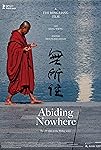Eye For Film >> Movies >> Abiding Nowhere (2024) Film Review
Abiding Nowhere
Reviewed by: Sergiu Inizian

A shot of an empty sidewalk with graffiti on the wall. The sounds of cars and people dominate the moment. Slowly, a man dressed in a red robe enters the scene. He is barefoot and has a shaved head. For those familiar with Tsai Ming-liang's works, he is recognisable as Walker, the central figure of a series of meditative experiments which started in 2011. In the latest entry, which marks the character’s tenth appearance, the quiet monk navigates the streets of Washington DC, allowing the hectic American society to unfold before his presence. The Taiwanese director remains consistent in his determination to experiment with time, testing the audience's patience once again and rewarding those who seek tranquillity amid the rush of frantic life.
Played by Lee Kang-Sheng, a frequent collaborator of Tsai, the walker wanders through vast parks, train stations and around the imposing Washington Monument. The static camera captures life unfolding before the barely moving monk. Exploring the busy halls, serene vegetation and bustling streets, the director creates a canvas for meditation, offering the viewer more than enough space for thinking. As time unexpectedly extends its reach, seemingly insignificant details take on a different meaning. In the protagonist’s unassuming world, gusts of wind and the movement of clouds have the potential to alter the nuance of his unhurried path.

The monk’s journey is seemingly retraced by a young man (Anong Houngheuangsy) who’s walking around the same locations, albeit at a faster pace. His character breaks the spell of motionless moments, creating a contrasting sense of rhythm that adds a touch of vitality to Tsai's visual introspection. The younger man is a more effective vessel for exploring interior spaces, whether abandoned buildings or museums. As his gaze lands on the rich textures surrounding him, the viewer experiences an odd feeling of yearning, heightened by the strange allure of ruins or ancient artefacts.
Tsai captures moments of fascination in which random passersby stop to absorb the walker's peculiarity. They briefly take an interest in him and walk away, drifting along the protagonist, like a stream around a rock, never catching his attention or altering his deliberate pace. Effectively contrasting trivial curiosity and dignified focus, Abiding Nowhere becomes a necessary study of awareness - a quality which seems in short stock nowadays.
The latest entry in the Walker series is unsurprisingly sluggish and has little interest in weaving a cohesive story. Saying it challenges the audience's patience is an understatement. But embracing the static long shots of the monk, as he navigates modern life, is undoubtedly rewarding. His rigorous journey conveys a deep sense of beauty. Accompanied by brief inserts of a serene chime, his path achieves a peaceful nature, which feels enough for the director. He is confident in what his Walker can achieve on-screen and remains consistent in a motionless cinematic style that feels unique in an increasingly hectic world.
Reviewed on: 24 Feb 2024
















